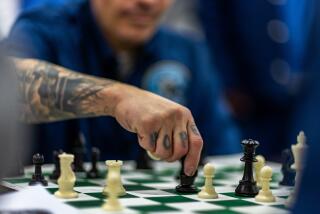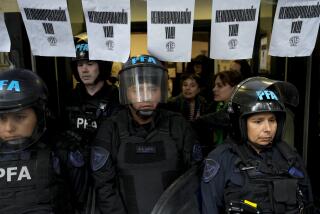Argentina Pulls Facade Off Ugly Past
- Share via
BUENOS AIRES — For more than 20 years, the imposing buildings on this capital’s Liberator Avenue have stood as a conspicuous monument to denial.
As many as 5,000 people were killed inside the notorious Navy Mechanics School, used as a concentration camp by Argentina’s military junta. The letters above the columned facade still announce Escuela Mecanica de la Armada -- words that to many Argentines carry sickening connotations.
Yet since the end of the “dirty war” that right-wing death squads and the junta waged against “subversives” in the 1970s and ‘80s, naval officers have continued to work inside the fenced campus as if nothing happened there.
This month, Argentine President Nestor Kirchner will change that.
On March 24, the 28th anniversary of the coup that brought the junta to power, the naval school will officially become a Museum of Memory. It will serve as Argentina’s first national memorial to those killed by the junta and a landmark in the long campaign -- since the return to democracy two decades ago -- to have the dirty war’s dead officially recognized.
Pregnant detainees gave birth inside its walls, their babies confiscated for secret adoptions. Inmates were drafted into slave labor. Its basement classrooms became the settings for torture. Most incarcerated there were never seen again, their bodies buried in secret or dumped from airplanes into the Atlantic Ocean.
“Transforming the Mechanics School into a space of memory is a vindication of the victims,” said Miryam Lewin, a journalist who was interned there. “No one who passes by that place can do so without remembering what happened inside.”
The creation of the Museum of Memory is one in a string of actions since Kirchner took office last year that have dramatically changed Argentina’s official stance toward the crimes of the dirty war. In a largely symbolic act in August, the Argentine Congress voted to overturn the “due obedience” and “final point” laws, which granted amnesty to officers implicated in human rights abuses and prevented further prosecution. Both laws are expected to be formally overturned by the Supreme Court this year.
Kirchner also announced that Argentina would no longer fight the extradition of former officers charged in European courts with the deaths of European nationals. And Argentine judges have taken on a new aggressiveness in prosecuting accused repressors: More than 70 military officers are in custody pending trials.
The government also recently raised the official estimate of the junta’s slayings from 10,000 to 13,000.
“We have a president now who has the political will to end the impunity and who does not say that we should forget the past, but instead works to keep memory of the dead alive,” said Estela Carlotto of the Grandmothers of the Plaza de Mayo, which represents relatives of the children taken by the military in illegal adoptions.
Rodolfo Mattarollo of the government’s Secretariat of Human Rights says the museum at the notorious school will draw lessons from similar facilities, such as the Holocaust Memorial Museum in Washington and Anne Frank House in Amsterdam.
“This is the strongest symbol we have of the repression,” Mattarollo said. “It is essential that it be preserved to educate future generations.”
Although hailed by many Argentines, the decision was opposed in a series of editorials by the conservative, influential Buenos Aires newspaper La Nacion.
A Feb. 18 editorial accused the government of implicitly siding with the “bands of terrorists” the junta fought during the dirty war. “It is indispensable that the authorities place themselves above the antagonisms and hatreds of the past,” the editorial said.
In the past, officers have made similar arguments, but political realities have changed since Kirchner became president. Shortly after taking power in May, Kirchner forced two dozen top generals and admirals into retirement.
On Wednesday, the head of the Argentine navy recognized for the first time that horrific crimes had been committed inside the Mechanics School, calling the complex “a symbol of barbarity.”
“That place, which should have been used exclusively for the professional formation of our officers, was used for the commission of abhorrent acts against human dignity, ethics and the law,” Adm. Jorge Godoy said in a speech before hundreds of naval officers.
A handful of retired officers walked out in protest.
“It’s just that the sun is too bright,” one of the protesting retirees told the newspaper Clarin, with a wry grin on his face. “It’s bad for your health.”
One of the most infamous officers of the Mechanics School, Alfredo Astiz -- known to his victims as the Angel of Death -- has lived free for almost all of the last two decades, despite myriad accusations against him in Argentina and Europe. He has been detained since September, however, when a judge refused to recognize the amnesty law.
In January, another officer linked to the camp, Juan Barrionuevo, was arrested as he was about to be sworn into the legislature in Tierra del Fuego province. Three former inmates of the Mechanics School stepped forward to say Barrionuevo had been a navy nurse known by the nickname “the Syringe.” He allegedly revived inmates who lost consciousness so they could continue being tortured.
One former inmate who traveled to Tierra del Fuego to testify against Barrionuevo was Victor Basterra. Detained in 1978, Basterra survived inside the Mechanics School for four years because he was a photographer by trade, a skill that proved useful to his jailers.
The navy officers put Basterra to work taking portraits to be used in false documents that officers and sailors used during kidnappings. Basterra also smuggled out dozens of photographs of prisoners who later disappeared. Executed in secret, their bodies were never found. The military claimed that they hadn’t been detained in the first place.
Such evidence proved crucial in the 1985 trial of Adm. Emilio Massera, the commander of the Mechanics School. A tribunal sentenced him to life in prison, but he spent only five years in custody before being released.
Massera was arrested again in 1998 and eventually convicted of kidnapping babies born to detainees at the school, a crime not covered by the amnesty law. On Wednesday, Germany formally requested his extradition on charges linked to the deaths of German Argentines in the camp.
Whether or not he is extradited, the picture of the square-jawed Massera will almost certainly occupy a space in the new Museum of Memory.
More to Read
Sign up for Essential California
The most important California stories and recommendations in your inbox every morning.
You may occasionally receive promotional content from the Los Angeles Times.














